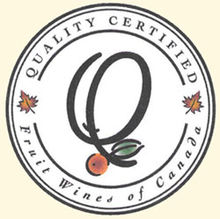- Ontario wine
-
Ontario wine is Canadian wine produced in the province of Ontario. Wines made from 100% Ontario grapes can qualify for classification under Ontario's appellation system, the Vintners Quality Alliance (VQA), depending on the varietal, the wine-making techniques employed, and other restrictions. Although this has been an issue with certain wineries where they use newer 100% Ontario hybrid-grapes to allow a longer growing season, these grapes have not been recognized by the VQA despite lobbying attempts to update their list of acceptable grapes.
Despite the large number of awards which top-quality Ontario wines have been receiving, not all Ontario wine is classified as VQA. Wines which are not labelled VQA and from certain producers (given special rights under the 1988 Canada-United States Free Trade Agreement) can use a high proportion of foreign bulk wine to produce a product which is labelled as Cellared in Canada. Significant parts of the wine industry, and respected wine writers in Canada and abroad, are quite concerned about this practice.
However, some wines which are not VQA are still genuine Ontario product, such as in cases where the producer is outside of a VQA recognized growing region, or is using non-VQA grape varieties or techniques.
Contents
Climate
Southern Ontario is in roughly the same latitude as southern France (Provence and the Languedoc). These regions have a tradition of growing tender fruit such as apricots and peaches, and has the growing conditions to consistently ripen many varieties of vitis vinifera.
Grapegrowing in Ontario has its challenges. At times, wine regions in Ontario suffer from harsh winters which can damage tender vines. In addition, its humid summers can provide conditions for fungal diseases. However, recent decades have seen the development of vineyard management techniques (for example, the use of wind machines in vineyards) and variety selection to meet these challenges. Ontario vineyards continue to progress in viticultural techniques to improve fruit quality for wine production.
Varieties and styles
The most prominent varieties of grapes grown in Ontario are:
For red wine and rose production:
- Cabernet Franc
- Merlot
- Pinot Noir
- Gamay Noir
- Cabernet Sauvignon
- Syrah
- Marechal Foch
- Baco noir
- Petit Verdot
- Malbec
- Zweigelt
For whites:
- Riesling
- Chardonnay
- Pinot Gris
- Gewürztraminer
- Viognier
- Sauvignon Blanc
- Semillon
- Pinot blanc
- Vidal
- Kerner
- Muscat Ottonel
For ice wines and late harvest dessert wines:
The most successful wines (other than ice wines) are made of Riesling (many slightly off-dry, in German style, with some excellent dry examples) and Chardonnay (cool-climate style). Red wines can be very good, especially ones from the dry and warm vintages (like 2002 and 2007) with the most promise shown by Pinot Noir, Cabernet Franc and Gamay Noir.
Growing regions
There are four official growing regions in the province recognized by the VQA.
The Niagara Peninsula, with the most area under vine and a series of newly recognized sub-appellations, is Canada's largest wine growing region and is blessed by a unique micro-climate facilitated by the interaction of the Niagara Escarpment and Lake Ontario.
In the Niagara Peninsula there are several sub-appellations which each have unique growing conditions suited to different grape varieties. They are: Niagara River, Niagara Lakeshore, Four Mile Creek, St. David's Bench, Niagara-on-the-Lake, Creek Shores, Lincoln Lakeshore, Short Hills Bench, Twenty Mile Bench, Beamsville Bench, Vinemount Ridge, and Niagara Escarpment.
The north shore of Lake Erie, and Pelee Island (in Lake Erie) are more southerly and receive many growing degree days, although Lake Erie freezes over in the winter.
In addition Prince Edward County has most recently become a recognized wine growing region in Ontario. Some see the future of wine in "the county" in premium wines produced in the style of Burgundy, such as Pinot Noir and Chardonnay.
There have been ongoing smaller scale attempts to grow wine in other, cooler, areas of the province using cold hardy, often hybrid grape varieties. Such is the case of Bruce County which encompasses the northern portion of the Niagara Escarpment which also runs through the Niagara wine growing region.
Fruit wine
Ontario is also home to wineries specializing in fruit wine. These wines are outside the scope of the VQA, but Fruit Wines of Canada has developed the Quality Certified (QC) mark to identify quality Canadian fruit wine that is not made from grapes. Ontario-grown fruits used to make these wines include (but are not limited to) apple, apricot, black currant, blackberry, blueberry, cherry, cranberry, elderberry, gooseberry, huckleberry, nectarine, peach, pear, plum, red currant, raspberry, saskatoon berry, and strawberry.
Some fruit wineries carry other products that are not made from fruit, including wines made from rhubarb, maple syrup, and honey.
Occasionally fruit wines are combined with grape wine, mead, or other fruit wines to produce unique flavour combinations.
In some cases, these wines can include other ingredients such as chocolate (e.g. in cherry or blueberry wines) or spices (e.g. in apple wines).
See also
- Canadian wine
- Cool Climate Oenology and Viticulture Institute
- Vintners Quality Alliance
- Ice wine
- Niagara Peninsula
- Short Hills Bench
- Prince Edward County Wine
References
External links
Categories:- Canadian wine
- Wine regions of Ontario
Wikimedia Foundation. 2010.

